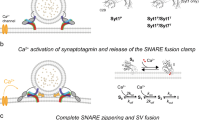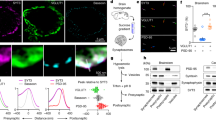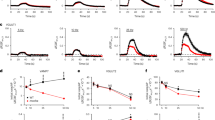Abstract
Neurotransmitter release is triggered by an increase in the cytosolic Ca2+ concentration ([Ca2+]i), but it is unknown whether the Ca2+-sensitivity of vesicle fusion is modulated during synaptic plasticity. We investigated whether the potentiation of neurotransmitter release by phorbol esters1,2,3, which target presynaptic protein kinase C (PKC)/munc-13 signalling cascades4,5,6, exerts a direct effect on the Ca2+-sensitivity of vesicle fusion. Using direct presynaptic Ca2+-manipulation and Ca2+ uncaging at a giant presynaptic terminal, the calyx of Held, we show that phorbol esters potentiate transmitter release by increasing the apparent Ca2+-sensitivity of vesicle fusion. Phorbol esters potentiate Ca2+-evoked release as well as the spontaneous release rate. We explain both effects by an increased fusion ‘willingness’ in a new allosteric model of Ca2+-activation of vesicle fusion. In agreement with an allosteric mechanism, we observe that the classically high Ca2+ cooperativity in triggering vesicle fusion (∼ 4) is gradually reduced below 3 µM [Ca2+]i, reaching a value of <1 at basal [Ca2+]i. Our data indicate that spontaneous transmitter release close to resting [Ca2+]i is a consequence of an intrinsic property of the molecular machinery7,8 that mediates synaptic vesicle fusion.
This is a preview of subscription content, access via your institution
Access options
Subscribe to this journal
Receive 51 print issues and online access
$199.00 per year
only $3.90 per issue
Buy this article
- Purchase on Springer Link
- Instant access to full article PDF
Prices may be subject to local taxes which are calculated during checkout




Similar content being viewed by others
References
Malenka, R. C., Madison, D. V. & Nicoll, R. A. Potentiation of synaptic transmission in the hippocampus by phorbol ester. Nature 321, 175–177 (1986)
Shapira, R., Silberberg, S. D., Ginsburg, S. & Rahamimoff, R. Activation of protein kinase C augments evoked transmitter release. Nature 325, 58–60 (1987)
Yawo, H. Protein kinase C potentiates transmitter release from the chick ciliary presynaptic terminal by increasing the exocytotic fusion probability. J. Physiol. (Lond.) 515, 169–180 (1999)
Hori, T., Takai, Y. & Takahashi, T. Presynaptic mechanism for phorbol ester-induced synaptic potentiation. J. Neurosci. 19, 7262–7267 (1999)
Rhee, J.-S. et al. β phorbol ester- and diacylglycerol-induced augmentation of transmitter release is mediated by munc13s and not by PKCs. Cell 108, 121–133 (2002)
Silinsky, E. M. & Searl, T. J. Phorbol esters and neurotransmitter release: More than just protein kinase C? Br. J. Pharmacol. 138, 1191–1201 (2003)
Chen, Y. A. & Scheller, R. H. SNARE-mediated membrane fusion. Nature Rev. Mol. Cell Biol. 2, 98–106 (2001)
Jahn, R., Lang, T. & Südhof, T. C. Membrane fusion. Cell 112, 519–533 (2003)
Bollmann, J., Sakmann, B. & Borst, J. Calcium sensitivity of glutamate release in a calyx-type terminal. Science 289, 953–957 (2000)
Schneggenburger, R. & Neher, E. Intracellular calcium dependence of transmitter release rates at a fast central synapse. Nature 406, 889–893 (2000)
Felmy, F., Neher, E. & Schneggenburger, R. Probing the intracellular calcium sensitivity of transmitter release during synaptic facilitation. Neuron 37, 801–811 (2003)
Wu, X. S. & Wu, L. G. Protein kinase C increases the apparent affinity of the release machinery to Ca2+ by enhancing the release machinery downstream of the Ca2+ sensor. J. Neurosci. 21, 7928–7936 (2001)
Ishikawa, T., Sahara, Y. & Takahashi, T. A single packet of transmitter does not saturate postsynaptic glutamate receptors. Neuron 34, 613–621 (2002)
Gillis, K. D., Mößner, R. & Neher, E. Protein kinase C enhances exocytosis from chromaffin cells by increasing the size of the readily releasable pool of secretory granules. Neuron 16, 1209–1220 (1996)
Stevens, C. F. & Sullivan, J. M. Regulation of the readily releasable vesicle pool by protein kinase C. Neuron 21, 885–893 (1998)
Sakaba, T. & Neher, E. Calmodulin mediates rapid recruitment of fast-releasing synaptic vesicles at a calyx-type synapse. Neuron 32, 1119–1131 (2001)
Deitcher, D. L. et al. Distinct requirements for evoked and spontaneous release of neurotransmitter are revealed by mutations in the Drosophila gene neuronal-synaptobrevin. J. Neurosci. 18, 2028–2039 (1998)
Schoch, S. et al. SNARE function analyzed in synaptobrevin/VAMP knockout mice. Science 294, 1117–1122 (2001)
Washbourne, P. et al. Genetic ablation of the t-SNARE SNAP-25 distinguishes mechanisms of neuroexocytosis. Nature Neurosci. 5, 19–26 (2002)
Yang, Y., Udayasankar, S., Dunning, J., Chen, P. & Gillis, K. D. A highly Ca2+-sensitive pool of vesicles is regulated by protein kinase C in adrenal chromaffin cells. Proc. Natl Acad. Sci. USA 99, 17060–17065 (2002)
Monod, J., Wyman, J. & Changeux, J.-P. On the nature of allosteric transitions: A plausible model. J. Mol. Biol. 12, 88–118 (1965)
Li, J., Zagotta, W. N. & Lester, H. A. Cyclic nucleotide-gated channels: structural basis of ligand efficacy and allosteric modulation. Q. Rev. Biophys. 30, 177–193 (1997)
Zhu, H., Hille, B. & Xu, T. Sensitization of regulated exocytosis by protein kinase C. Proc. Natl Acad. Sci. USA 99, 17055–17059 (2002)
Stevens, C. F. & Wesseling, J. F. Augmentation is a potentiation of the exocytotic process. Neuron 22, 139–146 (1999)
Scanziani, M., Capogna, M., Gähwiler, B. H. & Thompson, S. M. Presynaptic inhibition of miniature excitatory synaptic currents by baclofen and adenosine in the hippocampus. Neuron 9, 919–927 (1992)
Piedras-Rentería, E. S. et al. Presynaptic homeostasis at CNS nerve terminals compensates for lack of a key Ca2+ entry pathway. Proc. Natl Acad. Sci. USA 101, 3609–3614 (2004)
Delaney, K. R. & Tank, D. W. A quantitative measurement of the dependence of short-term synaptic enhancement on presynaptic residual calcium. J. Neurosci. 14, 5885–5902 (1994)
Angleson, J. K. & Betz, W. J. Intraterminal Ca2+ and spontaneous transmitter release at the frog neuromuscular junction. J. Neurophysiol. 85, 287–294 (2001)
Acknowledgements
We thank E. Neher for discussions, and P. Ascher, F. Felmy, E. Neher, T. Sakaba and M. Wölfel for comments on the manuscript. This work was supported by the Deutsche Forschungsgemeinschaft (DFG). R.S. is a Heisenberg fellow of the DFG.
Author information
Authors and Affiliations
Corresponding author
Ethics declarations
Competing interests
Reprints and permissions information is available at npg.nature.com/reprintsandpermissions. The authors declare no competing financial interests.
Supplementary information
Supplementary Figures
This file contains Supplementary Figures S1 and S2 and accompanying legends. Supplementary Figure S1 shows that EPSCs evoked by Ca2+-uncaging, and by brief presynaptic depolarizations are potentiated with a similar time-course by 1 µM PDBu, but the potentiation is transient under conditions of presynaptic whole-cell recording. Supplementary Figure S2 shows that EPSCs evoked by brief, and by prolonged presynaptic depolarizations are potentiated differentially by 1 µM PDBu, suggesting that the size of a readily-releasable vesicle pool is unchanged by PDBu. Furthermore, Ca2+-currents evoked by brief presynaptic depolarizations are slightly (∼15 %) increased by 1 µM PDBu. (DOC 1144 kb)
Rights and permissions
About this article
Cite this article
Lou, X., Scheuss, V. & Schneggenburger, R. Allosteric modulation of the presynaptic Ca2+ sensor for vesicle fusion. Nature 435, 497–501 (2005). https://doi.org/10.1038/nature03568
Received:
Accepted:
Issue Date:
DOI: https://doi.org/10.1038/nature03568
This article is cited by
-
The release of inhibition model reproduces kinetics and plasticity of neurotransmitter release in central synapses
Communications Biology (2023)
-
Asynchronous glutamate release is enhanced in low release efficacy synapses and dispersed across the active zone
Nature Communications (2022)
-
Electrostatic regulation of the cis- and trans-membrane interactions of synaptotagmin-1
Scientific Reports (2022)
-
A first-passage approach to diffusion-influenced reversible binding and its insights into nanoscale signaling at the presynapse
Scientific Reports (2021)
-
Early exposure to radiofrequency electromagnetic fields at 1850 MHz affects auditory circuits in early postnatal mice
Scientific Reports (2019)
Comments
By submitting a comment you agree to abide by our Terms and Community Guidelines. If you find something abusive or that does not comply with our terms or guidelines please flag it as inappropriate.



